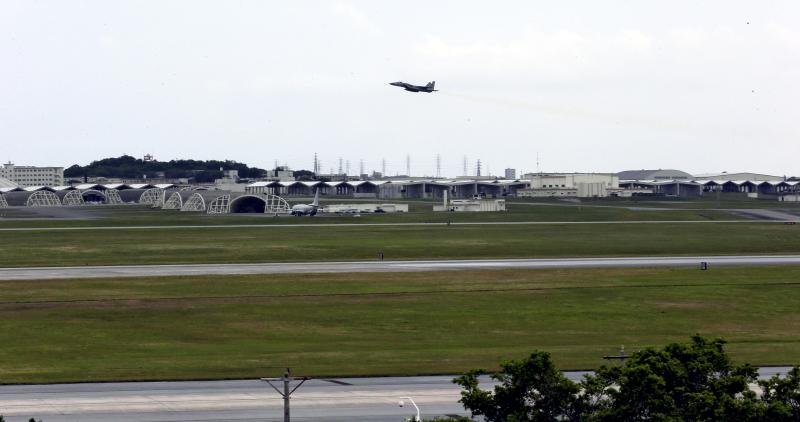Okinawa 50 years since return: Living with U.S. bases 2 / When Okinawan land is vacated by U.S. forces, multiple owners must reach consensus

A stretch of land is seen at the U.S. Kadena Air Base in Kadena, Okinawa Prefecture, on March 15. About 90% of the base site is privately owned.
The Yomiuri Shimbun
12:00 JST, March 31, 2022
Kadena Air Base, a U.S. military facility stretching over the town of Kadena and other municipalities near the middle of the main island of Okinawa Prefecture, is a key base for the security of Asia and the Pacific region. Day after day, fighter jets take off and land there.
On March 16, when North Korea launched a projectile, reconnaissance aircraft were seen at the base, and the atmosphere was tense.
The base sprawls over 1,986 hectares, or nearly 20 square kilometers of land — about 90% of which is privately owned. The Japanese government has taken on leases from about 13,000 landowners as “land for military purposes,” and provides the site to the U.S. military.
In recent years, military-purpose land in Okinawa, including the land under this air base, has drawn attention as an investment. This is because the annual rent, with the government as lessee, have been on the rise.
“Kadena Air Base is the most popular,” said Yuto Yoshizawa, 29, of a real estate firm in Urasoe. “As the possibility of the land being returned to Japan is low, owners can earn rent stably into the future. Its popularity will continue.”
The land used by the U.S. forces in Japan is owned either privately or by the state. On the main islands of Japan, nearly 90% of the land used by the U.S. military is owned by the state, while about 40% of the land used in Okinawa is owned privately.
One reason for the high percentage of private ownership in Okinawa dates back to the Battle of Okinawa in 1945. After the war, the U.S. forces seized many lots of land and moved ahead with building their bases there, without paying rent.
As Japan underwent a transition from “wartime” to “peacetime” after the San Francisco Peace Treaty took effect in April 1952, the U.S. government issued land expropriation orders, trying to move ahead with the compulsory seizure of land lawfully.
Choko Kuwae, the first chairman of the Federation of Landowners Association of Land used for Military Purposes in Okinawa Prefecture, expressed anger at the U.S. moves. He demanded of the United States that it pay rent to landowners, asserting: “They are plots of land owned by Okinawans. Such an injustice must not be permitted.”
But the U.S. government presented a policy of continuing to use the land for a low “lump-sum payment.” As opposition from the landowners escalated into a “struggle involving the whole island,” the U.S. side shifted its policy into one of paying rent to them every year.
As Okinawa was returned to Japan in 1972, the Japanese government concluded lease contracts with landowners. The government introduced a system under which the rents are decided through negotiations with the federation, to guard against developments such as landowners shifting to an “anti-base” stance and refusing to sign the contracts. In recent years, the rent has been rising by about 1% annually. For residents who were deprived of their land and placed in hard straits, it had become a big source of regular income, thus supporting their livelihoods.
Landowners also have a big influence on how former U.S. base sites are utilized.
The Naha Shin-toshin district, a 214-hectare new urban center in the prefectural capital, features tax-free shops and hotels in what was once a U.S. military housing area. The redevelopment project, however, faced rough going due to difficulty in reaching a consensus among landowners. It took over 30 years from the agreed return of the land for the redevelopment project to be completed in 2005.
Learning from that example, the Rycom district in Kitanakagusuku, completed its redevelopment project in just 10 years from the return of land. “The project proceeded smoothly, thanks to consensus-building among landowners, which went well,” Kazuhiro Kyan, 81, said.
Kyan, who owned the about 47-hectare site of a former golf course used by the U.S. military, spoke with pride in early March while looking at a large commercial complex that has opened on the former U.S. base site.
There were diverse intentions among the about 300 landowners involved, with some calling for selling off the land and others calling for leasing it. While an independent administrative institution of the central government served as the lead business entity for the Naha Shin-toshin project, a union of landowners took the lead in coordinating views over what to do with the returned land in the Rycom district.
Kyan recalled, “The success had much to do with the fact that most of the landowners were local residents, thus making consultations easier.”

A sign offering to buy military-purpose land stands beside a major road in Okinawa City on March 16.
In Okinawa, the return of large-scale, military-purpose land, including the Makiminato Service Area (or Camp Kinser) in Urasoe, and the Futenma Air Station in Ginowan, are in the offing. Yet, when it comes to how the returned land should be used, it is expected to be more difficult than ever for a consensus to be reached among landowners, mainly because the ownership of land for military purposes has become ever more fractionalized.
Keiichi Nakazato, a 49-year-old investment consultant from Tomigusuku, said: “When a land lot is inherited by multiple numbers of relatives, it will be fractionalized. Moreover, when an heir is hard-pressed to pay inheritance tax, or if their business goes slack amid the COVID-19 pandemic, for instance, they may sell their land lots by subdividing it.”
An increase in the number of landowners living outside Okinawa has also become a matter of concern. According to the Okinawa Defense Bureau, owners of military-purpose land at U.S. base sites in Okinawa numbered at about 46,600 as of the end of March last year. Of them, 4,051 live outside Okinawa, a 24% increase from four years earlier. The increase is said to result primarily from the idea of investing in such land being popularized in books and online.
Prof. Hiromori Maedomari at Okinawa International University, who specializes in the economics of U.S. bases, said: “As the rents also serve to compensate for the pain inflicted on landowners by the seizure of their land, an increase in landowners living outside Okinawa is not desirable. But this tendency will continue. In town-building projects in the future, the cooperation of landowners living outside Okinawa will become important.”
Popular Articles
Popular articles in the past 24 hours
-

Japan's H3 Rocket Failed in Latest Launch, Says Official
-

Quake Beneath Tokyo: Utilize New Damage Estimates for Disaster Ma...
-

Figure Skater Kaori Sakamoto Set to Compete at Olympics in Milan,...
-

Japanese Prime Minister Sanae Takaichi to Move into Official Resi...
-

JAXA Stops Rocket Launch Broadcast amid Engine Issues
-

Imperial Family Views Photo Exhibition Themed on Wartime Tokyo to...
-

JAXA Launches 8th H3 Rocket from Japan’s Kagoshima Pref.
-

Apple Growers in Japan's Aomori Turn to Peaches Amid Rising Tempe...
Popular articles in the past week
-

Israeli Tourists Refused Accommodation at Hotel in Japan’s Nagano...
-

U.S. Senate Resolution Backs Japan, Condemns China's Pressure
-

Kenta Maeda Joins Rakuten Eagles; Returns from American MLB to Ja...
-

Sharp Decline in Number of Chinese Tourists But Overall Number of...
-

China Attacks Japan at U.N. Security Council Meetings; Representa...
-

Japan Set to Participate in EU's R&D Framework, Aims to Boost Coo...
-

Japan Backs Public-Private Cooperation on Economic Security; Nati...
-

Bus Bound for Hokkaido's New Chitose Airport Catches Fire Wednesd...
Popular articles in the past month
-

Tokyo Economic Security Forum to Hold Inaugural Meeting Amid Tens...
-

Keidanren Chairman Yoshinobu Tsutsui Visits Kashiwazaki-Kariwa Nu...
-

Imports of Rare Earths from China Facing Delays, May Be Caused by...
-

University of Tokyo Professor Discusses Japanese Economic Securit...
-

Japan Pulls out of Vietnam Nuclear Project, Complicating Hanoi's ...
-

Govt Aims to Expand NISA Program Lineup, Abolish Age Restriction
-

Blanket Eel Trade Restrictions Rejected
-

Key Japan Labor Group to Seek Pay Scale Hike
"Society" POPULAR ARTICLE
-

M4.9 Earthquake Hits Tokyo, Neighboring Prefectures
-

Israeli Tourists Refused Accommodation at Hotel in Japan’s Nagano Pref., Prompting Protest by Israeli Embassy and Probe by Prefecture
-

M7.5 Earthquake Hits Northern Japan; Tsunami Waves Observed in Hokkaido, Aomori and Iwate Prefectures
-

Tsukiji Market Urges Tourists to Avoid Visiting in Year-End
-

M5.7 Earthquake Hits Japan’s Kumamoto Pref., Measuring Upper 5 Intensity, No Tsunami Expected
JN ACCESS RANKING
-

Tokyo Economic Security Forum to Hold Inaugural Meeting Amid Tense Global Environment
-

Keidanren Chairman Yoshinobu Tsutsui Visits Kashiwazaki-Kariwa Nuclear Power Plant; Inspects New Emergency Safety System
-

Imports of Rare Earths from China Facing Delays, May Be Caused by Deterioration of Japan-China Relations
-

University of Tokyo Professor Discusses Japanese Economic Security in Interview Ahead of Forum
-

Japan Pulls out of Vietnam Nuclear Project, Complicating Hanoi’s Power Plans






